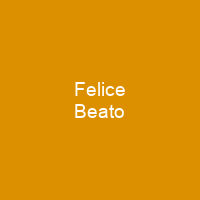Felice Beato: The Pioneering Photographer Who Shaped Our Perception of Asia
Imagine a time when the world was just beginning to open its eyes to the wonders of East Asia. Enter Felice Beato, an Italian-British photographer who captured these moments in ways that were both groundbreaking and unforgettable.
The Early Years: A Journey into Photography
Was Felice Beato born under a star that destined him for greatness? Born around 1832 in Venice, he was one of the first to take photographs in East Asia. His early life is shrouded in mystery, but it’s known that he moved to Corfu with his family at an early age and later became Robertson’s assistant before taking on a more active role in war zones.
War Photography: A Pioneering Endeavor
How did Beato capture the essence of conflict? He photographed the fall of Sevastopol with Robertson, documenting the aftermath of the Indian Rebellion of 1857. His work in war zones was not just about capturing moments; it was about preserving history for posterity.
The East: A New Frontier
From India to China, Beato’s journey through Asia was nothing short of a photographic odyssey. In China, he documented the Second Opium War, creating images that showed the devastation wrought by bombardments and looting.
The Summer Palace: A Glimpse into History
Beato’s photographs at Qingyi Yuan (the Summer Palace) captured a moment in time when this once-majestic palace was plundered. These images, hand-coloured and detailed, offer a unique perspective on the events that unfolded.
A New Home: Yokohama, Japan
Why did Beato choose to settle in Yokohama? By 1863, he had moved there and formed a partnership with Charles Wirgman. Together, they established one of the earliest commercial studios in Japan, producing illustrations and photographs that would shape perceptions of this new land.
The Japanese Series: A New Perspective
Beato’s work in Japan was revolutionary. He focused on portraying Japanese people uncondescendingly, capturing portraits, landscapes, cityscapes, and a series of Tōkaidō Road photographs that echoed the ukiyo-e woodblock prints.
A Photographer’s Legacy
How did Beato’s work influence others? He was the first photographer in Japan to sell albums of his works, recognizing their commercial potential. His hand-coloured photographs combined European photography with Japanese watercolourist techniques, setting a new standard for visual storytelling.
The Later Years: A Diverse Portfolio
In his later years, Beato’s portfolio expanded beyond Japan to include Burma and Egypt. He ran both his photography business and an antiques dealership successfully, capturing images that represented Burma’s image to the world.

For over fifty years, Felice Beato’s photographs of Asia had a significant impact on shaping Western notions of Asian societies. His work in travel diaries and published accounts was not just about capturing images; it was about preserving history for posterity. Through his lens, the world saw a new side of Asia, one that was both beautiful and complex.
You want to know more about Felice Beato?
This page is based on the article Felice Beato published in Wikipedia (retrieved on November 29, 2024) and was automatically summarized using artificial intelligence.







